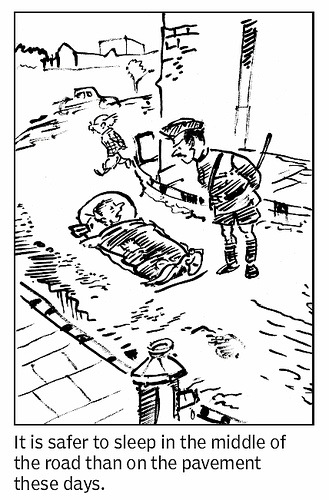§ Can YOU help former Marvel editor Scott Edelman find a picture from his past? He’s looking for a photo of him and his future wife from an early ’70s comic-con.
§ Shaenon T. Garrity strikes again with a list of Ten Defining Manga that couldn’t be better. In fact, I’m going to shove it under the nose of ANYONE expressing even the merest hint of interest in manga. Even Gary Groth would like these books.
This tentative, already overlong list is a survey of the manga that define manga: not necessarily the best manga of all time, although they’re all excellent, but the titles that best illustrate the development of manga from the 1950s onward. Even by that metric, the list is far from complete (No gag strips! Hardly any modern alternative manga!), but if you read these you’ll start to get an idea of what manga is all about.
§ Famed Indian cartoonist R.A. Laxman is in critical condition following a series of strokes. Laxman is 86 and well-known enough in his native land that his illness occasioned a slew of news stories.
§ The kids at Hooded Utilitarian kick around the relative merits of pop and art comics via Tintin and how its comics conventions work. Matthias Wivel presides:
The enduring popularity and greatness of Tintin, however, runs deeper, and it is inextricably bound up in the cartooning, not merely as storytelling but as personal handwriting. Peanuts wears Schulz’ emotions on its sleeve and is therefore more immediately appreciable as a work of literature than Tintin, which encrypts those of Hergé in a consciously dispassionate representational vocabulary.
The ligne claire, as it has become known, eschews hatching, downplays contrast, eliminates cast shadows, and maintains a uniformity of line throughout, paying equal attention to every element depicted. In his mature work, Hergé took great care to describe everything accurately, giving the reader a sense of authenticity and place. He did this not through naturalism, but rather through a careful distillation process, rendering every phenomenon in a carefully calibrated visual vocabulary that presents a seemingly egalitarian, ostensibly objective view of the world.
Some dissension in the comments.
Sean T. Collins touches on a similar theme while discussing Jeet Heer’s own comments on Dan Nadel’s anti-canon mingling of underground and commercial cartoonists in Art In Time:
But Dan wants to shake up our sense of history. I’ve taken the issue up with him during a panel in TCAF and he’s made the point elsewhere as well but in essence he’s challenging the view of old fogeys like me who see a major epistemological break between the world of commercial comic books and the world of the undergrounds. For Dan, it is all comics, and the formal properties that unite Marsh and Sharon Rudahl (for example) outweigh the social, cultural and economic divide….I’m not sure if I can define it in words, but the best underground comics (Crumb, Deitch, Spiegelman, Justin Green) cut deeper into human experience than any of the commercial cartoonists, no matter how good they were, ever did.
Collins feels that Heer’s old school compartmentalism doesn’t fly any more:
I think it’s pretty clear that from a critical-consensus standpoint, Heer has lost this particular argument. In large part, the task of the ’00s in both critical and comics-making terms was reclaiming commercial and genre comics as subjects worthy of investigation and capable of holding their own with the art/lit/underground end of things. Obviously, in his dual role as both critic and publisher, Nadel arguably represents the apotheosis of that viewpoint.
This is a fruitful line of enquiry; it seems to us that commercial considerations often trump intent; Krazy Kat (to pick a sublime example) is pretty clearly as personal to Herriman as Crumb’s autobio is to him, but the undergrounds were the blossoming of a reality where cartoonists could find an audience for their memoirs. There are certainly tons of crap commercial comics and crap autobiographical/memoir influenced comics; the critical task is winnowing wheat from chaff in every genre.
§ Also at THU, Erica Friedman on “The Solution to the Scanlation Solution.” It’s a very long piece, that we haven’t entirely digested yet.
I say that scanlation is a solution. The problem it solved was “things I want to read are not licensed for my country.” This was true in 1998 and now, in 2010, it is largely *still* true. I follow a genre called Yuri (lesbian-themed stories), which has had a Renaissance in Japan, but is almost completely unlicensed – and in many cases unlicensable, as the content is difficult, if not outright impossible to market in the western world.
§ A quick look at the new Harry Potter Theme Park – why has no one offered to give us a tour yet?
§ After a blogging break, Val is back, to our great relief, and she’s talking about 3D and iPads:
Same for reading comics on the iPad. I had an opportunity recently to read the first appearance of the Hulk on the iPad. Not only did each page look radiant and crisp, but every panel could be clicked to full-size, creating an almost pop-art effect. It was super-easy to navigate the pages, with no lag time for loading. And the iPad itself was as light as a trade paperback. I thought: reading comics on the iPad is here to stay.
Now, that doesn’t mean that I personally prefer reading comics on the iPad.







Great story once again. Thumbs up;)